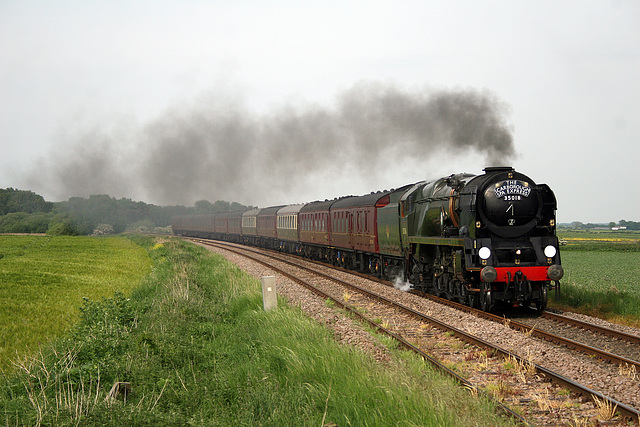Location
Lat, Lng: 54.201735, -0.464258
You can copy the above to your favourite mapping app.
Address: Staxton, Scarborough, North Yorkshire, England
You can copy the above to your favourite mapping app.
Address: Staxton, Scarborough, North Yorkshire, England
Keywords
Authorizations, license
-
Visible by: Everyone -
All rights reserved
-
290 visits
Bulleid M.N. class 4-6-2 35018 BRITISH INDIA LINE with 1Z23 17:15 Scarborough - Carnforth The Scarborough Spa Express at Willerby Carr Crossing 31st May 2018(steam as far as York)this was the first ever visit of a Merchant Navy class to Scarborough


The SR Merchant Navy class (originally known as the 21C1 class, and later informally known as Bulleid Pacifics, Spam Cans or Packets) is a class of air-smoothed 4-6-2 Pacific steam locomotives designed for the Southern Railway by Oliver Bulleid. The Pacific design was chosen in preference to several others proposed by Bulleid. The first members of the class were constructed during the Second World War, and the last of the 30 locomotives in 1949.
incorporating a number of new developments in British steam locomotive technology, the design of the Merchant Navy class was among the first to use welding in the construction process; this enabled easier fabrication of components during the austerity of the war and post-war economies. In addition the locomotives featured thermic syphons in their boilers and the controversial Bulleid chain-driven valve gear.The class members were named after the Merchant Navy shipping lines involved in the Battle of the Atlantic, and latterly those which used Southampton Docks, a publicity masterstroke by the Southern Railway, which operated Southampton Docks during the period.
Due to problems with some of the more novel features of Bulleid's design, all members of the class were modified by British Railways during the late 1950s, losing their air-smoothed casings in the process. The Merchant Navy class operated until the end of Southern steam in July 1967. A third of the class has survived and can be seen on heritage railways throughout Great Britain.
incorporating a number of new developments in British steam locomotive technology, the design of the Merchant Navy class was among the first to use welding in the construction process; this enabled easier fabrication of components during the austerity of the war and post-war economies. In addition the locomotives featured thermic syphons in their boilers and the controversial Bulleid chain-driven valve gear.The class members were named after the Merchant Navy shipping lines involved in the Battle of the Atlantic, and latterly those which used Southampton Docks, a publicity masterstroke by the Southern Railway, which operated Southampton Docks during the period.
Due to problems with some of the more novel features of Bulleid's design, all members of the class were modified by British Railways during the late 1950s, losing their air-smoothed casings in the process. The Merchant Navy class operated until the end of Southern steam in July 1967. A third of the class has survived and can be seen on heritage railways throughout Great Britain.
Nouchetdu38, Phil Sutters, Andy Rodker, Micky Mike and 4 other people have particularly liked this photo
- Keyboard shortcuts:
Jump to top
RSS feed- Latest comments - Subscribe to the comment feeds of this photo
- ipernity © 2007-2025
- Help & Contact
|
Club news
|
About ipernity
|
History |
ipernity Club & Prices |
Guide of good conduct
Donate | Group guidelines | Privacy policy | Terms of use | Statutes | In memoria -
Facebook
Twitter











Alan Drury club has replied to Nick Weall clubIt looks like the weed-killer train needs to be the next one to pass :))
Best wishes ... Steve
Alan Drury club has replied to SteCheers, Herb
Alan Drury club has replied to Herb Riddle clubA great picture of British India Line in action. Only the other day I found a u-tube video of its test outing, leaking steam all over the place!!!!
Glad they fixed it!
Best Wishes and a good weekend.
Peter
Alan Drury club has replied to Peter_Private_Box clubSign-in to write a comment.